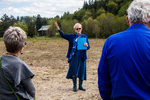



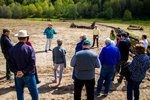
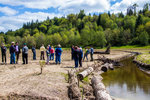


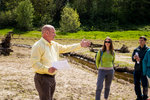

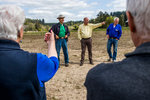
More than three years after beginning efforts to mitigate flooding out of China Creek into downtown Centralia, a ceremony Thursday afternoon marked the completion of the first of two parts to the project that has transformed about 25 acres of property off Little Hanaford Road.
Representatives from state offices, the Lewis County Board of County Commissioners and the city of Centralia gathered a few steps from the edge of the new waterway carved in a winding fashion to slow down the flow rate during times of high water. More than half a dozen people spoke during the short event, during which a common theme was carried throughout their remarks.
“This project is emblematic of the good that can be done through government partnerships,” said Scott Boettcher, staff member for the Chehalis River Basin Flood Authority. “These kinds of cutting-edge projects are highly collaborative, and this one happened on the back of a lot of collaboration we’ve been able to do all around the Chehalis Basin.”
Construction of the $2.1 million endeavor began in earnest last summer following a delay in funding caused by the state legislature failing in 2017 to pass a capital budget on time. Contractors from Kelso moved tens of thousands of cubic yards worth of dirt, using historic photos of the area to recreate the original shape of China Creek. The creek was shifted to flow along the roadway sometime decades ago in preparation for land development that never materialized.
Former Centralia Public Works Director Kahle Jennings started the process of working with the flood authority on China Creek prior to his retirement in 2017. Jennings attended Thursday’s ceremony, where he credited Mark White, Director of Natural Resources for the Chehalis Confederated Tribes, with suggesting stakeholders prioritize reshaping the creek over renovations to the Agnew Mill Ponds downstream, now slated for completion in late 2020 or early 2021.
“(White) was the one who told me our focus should be on doing this part first,” Jennings said. “A project like this doesn’t happen overnight or by just one agency.”
The combination of slowing water flow via phase one and storing water in phase two of the China Creek project is expected to drastically reduce the risk of flooding in downtown Centralia. The creek runs underneath City Hall, cuts across commercial lots and through residential areas.
Washington Gov. Jay Inslee’s office sent senior environmental policy advisor Robert Duff to view the finished product and share a few remarks with local elected officials. Duff praised the collaborative efforts of stakeholders within the Chehalis Basin, stating that as a major reason why projects such as China Creek get funded and get done. He added that increased funding given to the Office of the Chehalis Basin, which oversees the flood authority and received $73.2 million in the 2019-2021 capital budget, is evidence of something being done right.
“We used to say you were following in the footsteps of the Yakima Basin Integrated Plan,” Duff said. “I’m not saying that anymore. Now you’re on an equal par.”
Current Centralia Public Works Director Kim Ashmore said Thursday there is still some ongoing work to be completed on the first phase this summer while city staff works to get permits and plans complete for phase two by the end of this year.
Grass is struggling to grow on one section of the property, which was recently reseeded. Sandbags are holding water back on the portion of the creek that flows through that area until the grass takes, which may require the city to access a nearby water main to spur it along during the summer months. Once that happens, a berm created during construction will be pushed into the old creek along Little Hanaford Road.
The second phase of the flood mitigation project will involve the raising of the Angew Mill Ponds near Gold Street that were once used by a large sawmill of the same name. Work there may include the addition of a system to control how much water is retained in the ponds and meter the flow of excess water during flood conditions.
Phase two is anticipated to cost around $2.4 million and is slated to go out to bid early in 2020.